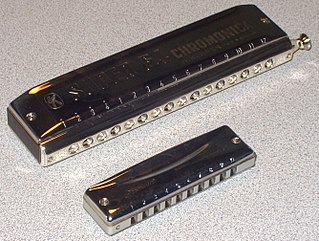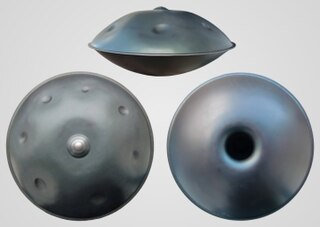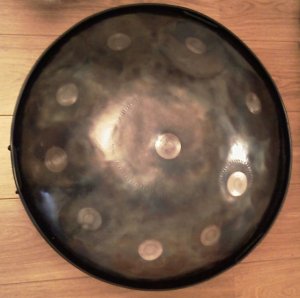
A steel tongue drum, tank drum, or hank drum is a round steel slit/tongue drum in the idiophone family originally fashioned from a propane cylinder.

A steel tongue drum, tank drum, or hank drum is a round steel slit/tongue drum in the idiophone family originally fashioned from a propane cylinder.
A steel tongue drum can be made from an empty, often 20-lb (9-kg) propane tank. The tank is flipped over and the base is cut or knocked off. Seven to ten tongues are then cut radially into the bottom of the tank, forming the top of the instrument. A steel tongue drum can also be made from a new unused tank head. The tongues can be tuned by the maker by varying the length of the cuts, or by adding weights, often neodymium magnets, to the tongues. Although steel tongue drums are often tuned to pentatonic scales, they can also be tuned to the diatonic scale, the chromatic scale, or any set of notes the maker chooses. The instrument is played with the fingers or with mallets. It boasts a pleasant, bell-like tone.[ citation needed ]
The steel tongue drum is based on the wooden slit drum. The slit drum is known to have been developed independently by multiple ancient civilizations including Africans, Aztecs, and Indonesians. They were used for both ritual and entertainment in these ancient civilizations. The steel tongue drum of today had several predecessors, most notably the Whale Drum in 1990 by Jim Doble and the Tambiro by Felle Vega. [1]
In February 2007, Dennis Havlena, [2] inspired by the physical properties of the Tambiro [3] and the tone layout of the Hang, created a steel tongue drum with a circular cross pattern layout from an empty 20-pound (9-kg) propane tank. The name 'Hank Drum' came from a combination of "Hang" and "tank". [4]
Dennis Havlena's instrument, in turn, has inspired other steel tongue drum inventions. Today, a lot of vendors offer commercial versions of the steel tongue drum worldwide.[ citation needed ]
Slit drums were originally built out of hollowed out logs or bamboo, but the steel tank drum is made from steel and often built from 20-gallon (9-kg) propane tanks. The construction is usually enclosed, unlike other open-bottom drums, so the sound produced resonates through the steel and vibrating air escaped from the slits. When building from a propane tank, the paint is usually ground off first, and then slits of the right lengths are cut. The drum is tuned by filing away some of the metal, or by adding material through soldering or welding.[ citation needed ]

The guitar is a stringed musical instrument, that is usually fretted and typically has six or twelve strings. It is usually held flat against the player's body and played by strumming or plucking the strings with the dominant hand, while simultaneously pressing selected strings against frets with the fingers of the opposite hand. A guitar pick may also be used to strike the strings. The sound of the guitar is projected either acoustically, by means of a resonant hollow chamber on the guitar, or amplified by an electronic pickup and an amplifier.
In music, a glissando is a glide from one pitch to another. It is an Italianized musical term derived from the French glisser, "to glide". In some contexts, it is equivalent to portamento, which is a continuous, seamless glide between notes. In other contexts, it refers to discrete, stepped glides across notes, such as on a piano. Some terms that are similar or equivalent in some contexts are slide, sweepbend, smear, rip, lip, plop, or falling hail. On wind instruments, a scoop is a glissando ascending to the onset of a note achieved entirely with the embouchure, except on instruments that have a slide.

The harmonica, also known as a French harp, mouth harp or mouth organ, is a free reed wind instrument used worldwide in many musical genres, notably in blues, American folk music, classical music, jazz, country, and rock. The many types of harmonica include diatonic, chromatic, tremolo, octave, orchestral, and bass versions. A harmonica is played by using the mouth to direct air into or out of one holes along a mouthpiece. Behind each hole is a chamber containing at least one reed. The most common is the diatonic Richter-tuned with ten air passages and twenty reeds, often called the blues harp. A harmonica reed is a flat, elongated spring typically made of brass, stainless steel, or bronze, which is secured at one end over a slot that serves as an airway. When the free end is made to vibrate by the player's air, it alternately blocks and unblocks the airway to produce sound.

In music, there are two common meanings for tuning:
In music theory, a scale is any set of musical notes ordered by fundamental frequency or pitch. A scale ordered by increasing pitch is an ascending scale, and a scale ordered by decreasing pitch is a descending scale.

The xylophone is a musical instrument in the percussion family that consists of wooden bars struck by mallets. Like the glockenspiel, the xylophone essentially consists of a set of tuned wooden keys arranged in the fashion of the keyboard of a piano. Each bar is an idiophone tuned to a pitch of a musical scale, whether pentatonic or heptatonic in the case of many African and Asian instruments, diatonic in many western children's instruments, or chromatic for orchestral use.
A pentatonic scale is a musical scale with five notes per octave, in contrast to the heptatonic scale, which has seven notes per octave.

The steelpan is a musical instrument originating in Trinidad and Tobago. Steelpan musicians are called pannists.

Temple blocks are a type of percussion instrument consisting of a set of woodblocks. It is descended from the muyu, an instrument originating from eastern Asia, where it is commonly used in religious ceremonies.

Developed and used by cultures living in forested areas, drums served as an early form of long-distance communication, and were used during ceremonial and religious functions.

A slit drum or slit gong is a hollow percussion instrument. In spite of its often being called a drum, it is not a true drum because it lacks a drumhead, the membrane stretched across the top of a true drum). It is classed instead as an idiophone in which the entire instrument vibrates, usually carved or constructed from bamboo or wood, in the form of a mostly closed hollow chamber with one or more slits in it. It is played by striking near the edge of the slit. In some designs, the slit is a single straight line; in others, the slit is used to create one or more "tongues", achieved by cutting three sides of a rectangular shape and leaving the fourth side attached. Most slit drums have one slit, though two and three slits occur. Tongues of different areas or thicknesses will produce different pitches. Slit drums are used throughout Africa, Southeast Asia, and Oceania. In Africa such drums, strategically situated for optimal acoustic transmission, have been used for long-distance communication.

The Richter-tuned harmonica, or 10-hole harmonica or blues harp, is the most widely known type of harmonica. It is a variety of diatonic harmonica, with ten holes which offer the player 19 notes in a three-octave range.
Notation plays a relatively minor role in the oral traditions of Indonesian gamelan but, in Java and Bali, several systems of gamelan notation were devised beginning at the end of the 19th century, initially for archival purposes.

The Hang is a type of musical instrument called a handpan, fitting into the idiophone class and based on the Caribbean steelpan instrument. It was created by Felix Rohner and Sabina Schärer in Bern, Switzerland. The name of their company is PANArt Hangbau AG. The Hang is sometimes referred to as a hang drum, but the inventors consider this a misnomer and strongly discourage its use.

Jazz improvisation is the spontaneous invention of melodic solo lines or accompaniment parts in a performance of jazz music. It is one of the defining elements of jazz. Improvisation is composing on the spot, when a singer or instrumentalist invents melodies and lines over a chord progression played by rhythm section instruments and accompanied by drums. Although blues, rock, and other genres use improvisation, it is done over relatively simple chord progressions which often remain in one key.

The caisa is a musical instrument made of steel and wood. The steel section resembles the top of a steelpan and the wooden base section resembles a horn-like stand. The steel and wood are held together with a stretchy rope material; there is no direct contact between the steel and the wood. Sound is emitted from the gap between the steel and the wood and not from the horn at the base. The tone areas are hammered by hand and are usually in a pentatonic scale comprising ten to twelve notes. The central note is much deeper.

Teochew string music or Chaozhou xianshi is classed as a type of sizhu music although it typically uses stringed instruments only. It is found in northeastern Guangdong and parts of Fujian and also in regions with overseas Teochew populations, such as Malaysia, Singapore, Thailand, and the United States. The Chaoshan region of Guangdong, bordering on Fujian and comprising the cities of Chaozhou, Shantou and Jieyang, forms its own cultural sphere. Teahouses often accompany with Chaozhou music.

Philippine traditional musical instruments are commonly grouped into four categories: aerophones, chordophones, membranophones, and idiophones.
Richter tuning is a system of choosing the reeds for a diatonic wind instrument. It is named after Joseph Richter, a Bohemian instrument maker who adopted the tuning for his harmonicas in the early 19th century and is credited with inventing the blow/draw mechanism that allows the harmonica to play different notes when the air is drawn instead of blown.

Handpan is a term for a group of musical instruments that are classified as a subset of the steelpan. Several handpan makers and brands have emerged in recent years, resulting from a growing worldwide interest in the Hang, which is an instrument developed by the company PANArt that is based on the physical properties of the Trinidadian steelpan, Indian ghatam, Thai gong and Indonesian Gamelan etc.